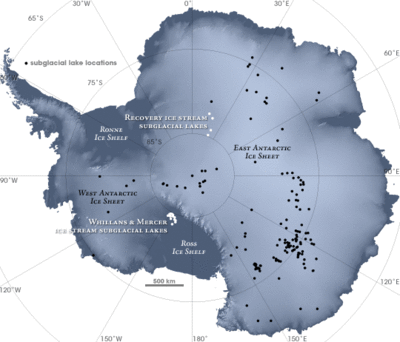Antarctic Lakes
Introduction
Antarctica offers nearly no opportunity for colonization, as it is almost entirely covered by ice. [(#References|[1]]] However, in the ice-free areas of the continent, lakes can exist. [1] These lakes vary in composition, ranging from freshwater to hyper saline, as well as being either permanently covered with ice, such as subglacial lakes, or depending on the season, temporarily covered with ice. [2] Research of these lakes provides new findings for microorganisms that can persist in these extreme environments, and have yet to be discovered elsewhere.

Physical Environment
Types of Lakes
Both subglacial and open lakes exist in Antarctica. Subglacial lakes are liquid water bodies that can be found under glaciers, ice caps or ice sheets. [3] Exploring subglacial antarctic lake environments. Eos, Transactions American Geophysical Union,86(20), 193. The largest of these lakes is Lake Vostok, which is covered by a 4km thick ice sheet [3]. The ice cover restricts interaction between the lake and the exterior environment [4] However, open lakes are not ice-covered, and usually have high salt concentrations. [4]
Salinity
There are a number of both fresh and saline water lakes in Antarctica. Saline lakes contain a total of 3% dissolved salts. [5] Steep gradients of salt concentration are present in these lakes, making them meromictic, resulting in different niches within the lake. [4] As well, freshwater lakes tend to average between 1-2 degrees Celsius, while saline lakes average below 0 degrees Celsius. [2]
Light
Availability of light depends on the thickness of ice covering the lake, if present. Solar radiation can be transmitted through thin ice sheets, but ice sheets of around 4-6m thick prohibit light penetration. [4] Low light levels correspond to low levels of photosynthesis, which may not be sufficient for microbial growth.Cite error: Closing </ref> missing for <ref> tag Where oxygen is available, phytoplankton uptake carbon during photosynthesis, converting CO2 into organic carbon.[1] Organic carbon from decomposing plankton, or other benthic microorganisms, is usually segregated into sediment through the process of sedimentation. [6] As well, viruses lyse host cells to return carbon to the carbon pool in its inorganic form, which then gets transferred to protozoa in the system. [1]
Nitrogen Cycle
Nitrogen is important for all organisms, as it is makes up nucleic and amino acids, which are essential for life. Fixed nitrogen enters lakes when glacial streams melt. [4] This nitrogen then becomes available for cyanobacteria to use for nitrogen fixation (Cowan and Tow 2004). Different processes of the nitrogen cycle are separated into different areas of the lake. When ammonium diffuses from anoxic layers, nitrifying bacteria use that ammonium to produce nitrate at the border between oxic and anoxic water. [7] When nitrate and nitrous oxide diffuse into the anoxic layers, denitrification occurs. [7] Decomposition also occurs within the anoxic layer, which releases ammonium through sulphate reduction. [7]
Key Microorganisms
Antarctic lakes do not have large food chains, as no fish are present, resulting in microbes dominating the system. Cite error: Closing </ref> missing for <ref> tag Some main viruses in these communities are single stranded DNA (ssDNA) viruses, which infect eukaryotes, and double stranded DNA (dsDNA) viruses, which infect algae. [8] However, there is a large diversity of viruses in these lakes, many of which that have yet to be identified. [8]
Current Research
1 Scientists are have recently researched the microbial diversity of a sediment sample from Lake Hodgson.[9] It was found that 77% of the microorganism diversity could be identified with previously found microbes, while 23% could not be recognized.[10] This indicates that a large number of microbes still remain unknown to scientists. Further research is necessary to continue to reveal more information on the diversity of microbes, and how they continue to live in the extreme Antarctic Lake conditions. [10]
2 Research in Deep Lake has demonstrated that horizontal gene transfer occurs quite frequently between microorganisms. [11] Large DNA segments are exchanged between different classes of microorganisms, leading to evolution.[11] This allows the microorganisms to avoid competition for resources, as the exchanged DNA helps with niche adaptation.[11]
References
- ↑ 1.0 1.1 1.2 Cite error: Invalid
<ref>tag; no text was provided for refs namedLay09 - ↑ 2.0 2.1 Laybourn-Parry, J. (2002). Survival mechanisms in antarctic lakes. Philosophical Transactions of the Royal Society of London.Series B: Biological Sciences, 357(1423), 863-869
- ↑ 3.0 3.1 Priscu, J. C., Tabacco, I., Kennicutt, M. C., Bell, R. E., Bulat, S. A., Ellis-Evans, J. C., and Siegert, M. J. (2005).
- ↑ 4.0 4.1 4.2 4.3 4.4 Cowan, D. A., and Tow, L. A. (2004). Endangered antarctic environments. Annual Review of Microbiology, 58(1), 649-690.
- ↑ Burton, H. R. (1981). 24. chemistry, physics and evolution of antarctic saline lakes: A review. Hydrobiologia, 81-82(1), 339-362.
- ↑ Wharton, J.,R A., McKay, C. P., Simmons, J.,G M., and Parker, B. C. (1986). Oxygen budget of a perennially ice-covered antarctic lake. Limnology and Oceanography, 31(2), 437.
- ↑ 7.0 7.1 7.2 Howard-Williams, C., and Hawes, I. (2007). Ecological processes in antarctic inland waters: Interactions between physical processes and the nitrogen cycle. Antarctic Science, 19(2), 205-217.
- ↑ 8.0 8.1 Cite error: Invalid
<ref>tag; no text was provided for refs namedLopez - ↑ Pearce, D.A., Hodgson, D.A., Thorne, M.A.S., Burns, G., and Cockell, C.S. (2013). Preliminary analysis of life within a former subglacial lake sediment in antarctica. Diversity, 5(3), 680-702.
- ↑ 10.0 10.1 Cite error: Invalid
<ref>tag; no text was provided for refs namedPearce - ↑ 11.0 11.1 11.2 Demaere, M. Z., Woyke, T., Kyrpides, N. C., Tringe, S. G., Cavicchioli, R., Williams, T. J., and Davenport, K. W. (2013). High level of intergenera gene exchange shapes the evolution of haloarchaea in an isolated antarctic lake. Proceedings of the National Academy of Sciences of the United States of America, 110(42), 16939.
